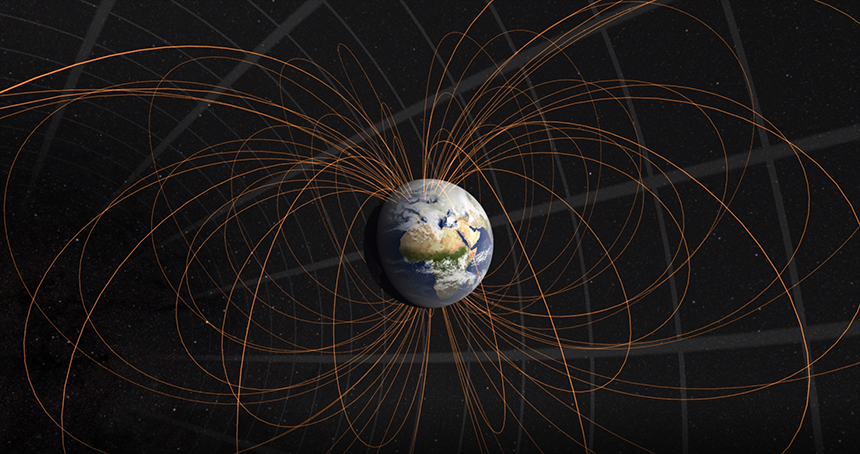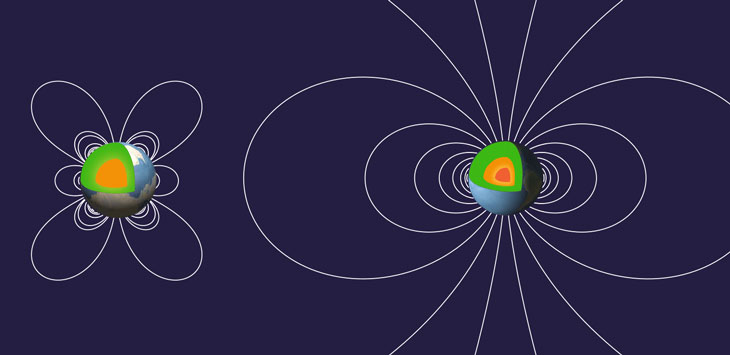Earth’s core may have hardened just in time to save planet’s magnetic field
Planet’s solid heart may be much younger than thought

Earth’s magnetic field (illustrated) is powered by the circulation of an iron-rich fluid in the planet’s core. The solid inner core formed relatively “late,” saving a weakening magnetic field from collapse.
Tom Bridgman/NASA’s Scientific Visualization Studio, JPL NAIF
The inner core of planet Earth was once molten. But it solidified within the past 565 million years, a new study suggests. That would have been just in time to save the planet’s protective magnetic field from imminent collapse. It also would have kick-started that field into its current, powerful phase, the study says.
Scientists shared their new analysis in the February Nature Geoscience.
It supports something previously suggested by a computer model. That model had proposed that Earth’s inner core is relatively young.
Earth formed some 4.54 billion years ago. The new study offers clues to how — and how quickly — Earth has been losing heat since its formed. And that is key to learning how the planet’s magnetic shield formed. It also offers insight into heat-related motions within the mantle (between Earth’s crust and core), as well as into plate tectonics.
“We don’t have many real benchmarks for the thermal history of our planet,” says Peter Olson. He’s a geophysicist at Johns Hopkins University in Baltimore, Md. He was not involved in the new study. “We know [Earth’s] interior was hotter than today, because all planets lose heat. But we don’t know what the average temperature was a billion years ago, compared with today.” Pinning down when iron in the inner core began to crystallize could offer a window into how hot the interior of the planet was back then, he says.
The planet’s core is made of iron and nickel and has two layers. The inner core is solid. Around it sits a molten outer core. When that solid inner core formed has been a long-standing mystery. People have suggested it could have been anywhere from 500 million years ago to more than 2.5 billion years ago, says coauthor John Tarduno. He’s a geophysicist at the University of Rochester in New York.
The core’s two layers interact. And that drives Earth’s geodynamo — the circulation of an iron-rich fluid that powers the planet’s magnetic field. That field surrounds the planet. And that’s a good thing. It protects Earth from being battered by the solar wind, a constant flow of charged particles from the sun.
As the inner core cooled and crystallized, the chemical recipe of its surrounding fluid changed. The more buoyant liquid would have risen like a plume. The cooling crystals would have sunk. That density-driven circulation was self-sustaining. And it has driven a strong magnetic field with two opposing poles, north and south.

Ancient magnetism
Scientists have found traces of magnetism in ancient rocks. Those rocks suggest that Earth had a magnetic field as far back as 4.2 billion years ago. That earlier field was likely generated by heat within the planet. That heat would have driven circulation within the molten core.
But over time, computer models suggest, the heat-driven circulation wouldn’t have been strong enough alone go on powering a strong magnetic field. Instead, the field would have begun to shut down. And old rocks show evidence of that in weakening magnetic field intensities and rapid reversals in Earth’s North and Sound poles over millions of years.
Eventually, Earth’s inner core began to crystallize. That would have jump-started the geodynamo. It also would have generated a new, stronger magnetic field.
Now scientists think they’ve found evidence for when that magnetic-field breakdown took place.
Inclusions are iron-rich, needlelike grains in rocks. Those inclusions align themselves with the orientation of Earth’s magnetic field when the rocks formed. Analyses of those inclusions show that the planet’s magnetic field was extremely weak some 565 million years ago. Richard Bono led the research team that had been looking at a suite of rocks from Quebec, Canada. A geophysicist, Bono now works at the University of Liverpool in England. Those very weak magnetic fields, Tarduno says, suggested there was something happening in the core.
Earlier studies had found that the magnetic field was also rapidly reversing its North-to-South polarity at that time. And with the new data, this research indicates that Earth’s field may have been on the point of collapse some 565 million years ago. That would seem to mean that the inner core had not yet become solid. Fortunately for life on Earth, it eventually did.
The new finding is “potentially very important,” says Olson at Johns Hopkins. The rocks bearing the magnetic grains took a very long time to cool. That means the new data represent an average field intensity over a 100,000-year period. He says Bono’s team hasn’t just captured a snapshot of some fluctuating field, but instead a true, persistent signal. Computer modeling had suggested that the weak field might have lasted much longer — from about 900 million to 600 million years ago, or until the inner core solidified. More data from within that time span, as well as from other locations, would help to confirm that.
Peter Driscoll is a geophysicist at the Carnegie Institution for Science in Washington, D.C. He was one of the scientists who estimated how long the weak phase might have lasted. Driscoll wrote a commentary that was published along with the new study. A young solid inner core also highlights lingering questions about how quickly Earth cooled, he notes. For example, “if the core is cooling quickly, that means it was very hot in the recent past, and that the lower mantle was very hot in the recent past.” Both could have still been molten just 1 billion to 2 billion years ago. “We absolutely do not see that in the rock record.”







